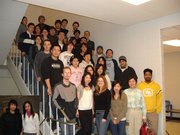07-401/Class Notes for April 11: Difference between revisions
No edit summary |
No edit summary |
||
| Line 2: | Line 2: | ||
{{In Preparation}} |
{{In Preparation}} |
||
The |
==The Fundamental Theorem of Galois Theory== |
||
It seems we will not have time to prove the Fundamental Theorem of Galois Theory in full. Thus this note is about what we will be missing. The statement appearing here, which is a weak version of the full theorem, is taken from Gallian's book and is meant to match our discussion in class. The proof is taken from Hungerford's book, except modified to fit our notations and conventions and simplified as per our weakened requirements. |
|||
| ⚫ | '''Theorem.''' Let |
||
Here and everywhere below our base field <math>F</math> will be a field of characteristic 0. |
|||
===Statement=== |
|||
| ⚫ | '''Theorem.''' Let <math>E</math> be a splitting field over <math>F</math>. Then there is a correspondence between the set <math>\{K:E/K/F\}</math> of intermediate field extensions <math>K</math> lying between <math>F</math> and <math>E</math> and the set <math>\{H:H<\operatorname{Gal}(E/F)\}</math> of subgroups <math>H</math> of the Galois group <math>\operatorname{Gal}(E/F)</math> of the original extension <math>E/F</math>: |
||
{{Equation*|<math>\{K:E/K/F\}\quad\leftrightarrow\quad\{H:H<\operatorname{Gal}(E/F)\}</math>.}} |
{{Equation*|<math>\{K:E/K/F\}\quad\leftrightarrow\quad\{H:H<\operatorname{Gal}(E/F)\}</math>.}} |
||
The bijection is given by mapping every intermediate extension <math>K</math> to the subgroup <math>\operatorname{Gal}(E/K)</math> of elements in <math>\operatorname{Gal}(E/F)</math> that preserve <math>K</math>, |
The bijection is given by mapping every intermediate extension <math>K</math> to the subgroup <math>\operatorname{Gal}(E/K)</math> of elements in <math>\operatorname{Gal}(E/F)</math> that preserve <math>K</math>, |
||
| Line 14: | Line 20: | ||
# It is degree/index respecting: <math>[E:K]=|\operatorname{Gal}(E/K)|</math> and <math>[K:F]=[\operatorname{Gal}(E/F):\operatorname{Gal}(E/K)]</math>. |
# It is degree/index respecting: <math>[E:K]=|\operatorname{Gal}(E/K)|</math> and <math>[K:F]=[\operatorname{Gal}(E/F):\operatorname{Gal}(E/K)]</math>. |
||
# Splitting fields correspond to normal subgroups: If <math>K</math> in <math>E/K/F</math> is a splitting field then <math>\operatorname{Gal}(E/K)</math> is normal in <math>\operatorname{Gal}(E/F)</math> and <math>\operatorname{Gal}(K/F)\cong\operatorname{Gal}(E/F)/\operatorname{Gal}(E/K)</math>. |
# Splitting fields correspond to normal subgroups: If <math>K</math> in <math>E/K/F</math> is a splitting field then <math>\operatorname{Gal}(E/K)</math> is normal in <math>\operatorname{Gal}(E/F)</math> and <math>\operatorname{Gal}(K/F)\cong\operatorname{Gal}(E/F)/\operatorname{Gal}(E/K)</math>. |
||
===Lemmas=== |
|||
The two lemmas below belong to earlier chapters but we skipped them in class. |
|||
====The Primitive Element Theorem==== |
|||
The celebrated "Primitive Element Theorem" is just a lemma for us: |
|||
'''Lemma.''' Let <math>a</math> and <math>b</math> be algebraic elements of some extension <math>E</math> of <math>F</math>. Then there exists a single element <math>c</math> of <math>E</math> so that <math>F(a,b)=F(c)</math>. (And so by induction, every finite extension of <math>E</math> is "simple", meaning, is generated by a single element, called "a primitive element" for that extension). |
|||
'''Proof.''' See the proof of Theorem 21.6 on page 375 of Gallian's book. |
|||
====Splitting Fields are Good at Splitting==== |
|||
Revision as of 14:15, 9 April 2007
| |||||||||||||||||||||||||||||||||||||||||||||||||||||||||
The information below is preliminary and cannot be trusted! (v)
The Fundamental Theorem of Galois Theory
It seems we will not have time to prove the Fundamental Theorem of Galois Theory in full. Thus this note is about what we will be missing. The statement appearing here, which is a weak version of the full theorem, is taken from Gallian's book and is meant to match our discussion in class. The proof is taken from Hungerford's book, except modified to fit our notations and conventions and simplified as per our weakened requirements.
Here and everywhere below our base field will be a field of characteristic 0.
Statement
Theorem. Let be a splitting field over . Then there is a correspondence between the set of intermediate field extensions lying between and and the set of subgroups of the Galois group of the original extension :
The bijection is given by mapping every intermediate extension to the subgroup of elements in that preserve ,
and reversely, by mapping every subgroup of to its fixed field :
Furthermore, this correspondence has the following further properties:
- It is inclusion-reversing: if then and if then .
- It is degree/index respecting: and .
- Splitting fields correspond to normal subgroups: If in is a splitting field then is normal in and .
Lemmas
The two lemmas below belong to earlier chapters but we skipped them in class.
The Primitive Element Theorem
The celebrated "Primitive Element Theorem" is just a lemma for us:
Lemma. Let and be algebraic elements of some extension of . Then there exists a single element of so that . (And so by induction, every finite extension of is "simple", meaning, is generated by a single element, called "a primitive element" for that extension).
Proof. See the proof of Theorem 21.6 on page 375 of Gallian's book.


















![{\displaystyle [E:K]=|\operatorname {Gal} (E/K)|}](https://wikimedia.org/api/rest_v1/media/math/render/svg/65c44a48df52c6cd4e1cf197de461b438c3270fd)
![{\displaystyle [K:F]=[\operatorname {Gal} (E/F):\operatorname {Gal} (E/K)]}](https://wikimedia.org/api/rest_v1/media/math/render/svg/93e40beb2ae7daa66244aff7daefbafd6cdeabf6)





